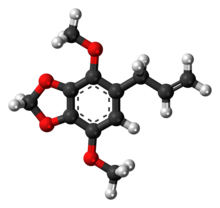Apiole

| |

| |
| Names | |
|---|---|
| Preferred IUPAC name
4,7-Dimethoxy-5-(prop-2-en-1-yl)-2H-1,3-benzodioxole | |
| Other names
5-Allyl-4,7-dimethoxybenzo[d][1,3]dioxole
1-Allyl-2,5-dimethoxy-3,4-methylenedioxybenzene | |
| Identifiers | |
3D model (JSmol)
|
|
| ChEBI | |
| ChEMBL | |
| ChemSpider | |
| ECHA InfoCard | 100.007.592 |
| EC Number |
|
| KEGG | |
PubChemCID
|
|
| UNII | |
CompTox Dashboard(EPA)
|
|
| |
| |
| Properties | |
| C12H14O4 | |
| Molar mass | 222.23 g/mol |
| Density | 1.151 g/mL |
| Melting point | 30 °C (86 °F; 303 K) |
| Boiling point | 294 °C (561 °F; 567 K) |
Except where otherwise noted, data are given for materials in theirstandard state(at 25 °C [77 °F], 100 kPa).
| |
Apioleis aphenylpropene,also known asapiol,parsley apiol,orparsley camphor.Its chemical name is 1-allyl-2,5-dimethoxy-3,4-methylenedioxybenzene. It is found in theessential oilsofceleryleaf and all parts ofparsley.[1]Heinrich Christoph Link, anapothecaryinLeipzig,discovered the substance in 1715 as greenish crystals reduced by steam from oil of parsley.[2]In 1855 Joret and Homolle discovered thatapiolwas an effective treatment ofamenorreaor lack ofmenstruation.
In medicine it has been used, as essential oil or in purified form, for the treatment of menstrual disorders and as an abortifacient. It is an irritant and, in high doses, it can cause liver and kidney damage.[3]Cases of death due to attempted abortion using apiole have been reported.[4][5]
Hippocrateswrote about parsley as an herb to cause anabortion.[6]Plants containing apiole were used by women in the Middle Ages to terminate pregnancies. Now that safer methods of abortion are available, apiol is almost forgotten.
Orthography
[edit]Apiole(always with the final 'e') is the correct spelling[citation needed]of the trivial name for 1-allyl-2,5-dimethoxy-3,4-methylenedioxybenzene.[7]Apiol,also known as liquid apiol or green oil of parsley, is the extractedoleoresinof parsley, rather than the distilled oil. Its use was widespread in the United States, often as ergoapiol or apergol, as an early form of birth control as well as for menstrual issues (and off label for abortions)until a highly toxic adulterated product containing apiol andtri-ortho-cresyl phosphate(also famous as the adulterant added toJamaican ginger) was introduced on the American market. 1'-sulfoxy metabolite formation for apiole (3,4-OMe-safrole) is about 1/3 as active as safrole.[8]No carcinogenicity was detected with parsley apiol or dill apiol in mice.[9]
Other similarly named compounds
[edit]The name apiole is also used for a closely related compound found indilland infennelroots, the positional isomer (dillapiole,1-allyl-2,3-dimethoxy-4,5-methylenedioxybenzene.Exalatacin(1-allyl-2,6-dimethoxy-3,4-methylenedioxybenzene) is another positional isomer of apiole, found in the Australian plantsCrowea exalataandCrowea angustifoliavar. angustifolia.[citation needed]
See also
[edit]References
[edit]- ^Azeez, Shamina; Krishnamurthy, K. (2008).Chemistry of Spices.Calicut, Kerala, India: Biddles Ltd. pp. 380 & 404.ISBN9781845934057.
- ^Shorter, Edward (1991).Women's Bodies: A Social History of Women's Encounter With Health, Ill-Health, and Medicine.New Brunswick, NJ: Transaction Publishers.[page needed]
- ^Amerio, A; De Benedictis, G; Leondeff, J; Mastrangelo, F; Coratelli, P (January 1968). "La nefropatia da apiolo" [Nephropathy due to apiol].Minerva Nefrologica(in Italian).15(1): 49–70.OCLC100396864.PMID5736450.
- ^Quinn, Louis J.; Harris, Cecil; Joron, Guy E. (15 April 1958)."Apiol Poisoning".Canadian Medical Association Journal.78(8): 635–636.PMC1829842.PMID20325694.
- ^Hermann, Kate; Le Roux, Anne; Fiddes, F.S. (June 1956). "Death from apiol used as abortifacient".The Lancet.267(6929): 937–939.doi:10.1016/s0140-6736(56)91522-7.PMID13320936.
- ^Sage-Femme Collective (2008).Natural Liberty: Rediscovering Self-induced Abortion Methods.Natural Liberty.ISBN978-0-9645920-0-1.[page needed]
- ^Shulgin, Alexander T. (April 1966)."Possible Implication of Myristicin as a Psychotropic Substance"(PDF).Nature.210(5034): 380–384.Bibcode:1966Natur.210..380S.doi:10.1038/210380a0.PMID5336379.S2CID4189608.[failed verification]
- ^Alajlouni, Abdalmajeed M.; Al_Malahmeh, Amer J.; Kiwamoto, Reiko; Wesseling, Sebastiaan; Soffers, Ans E.M.F.; Al-Subeihi, Ala A.A.; Vervoort, Jacques; Rietjens, Ivonne M.C.M. (March 2016)."Mode of action based risk assessment of the botanical food-borne alkenylbenzene apiol from parsley using physiologically based kinetic (PBK) modelling and read-across from safrole".Food and Chemical Toxicology.89:138–150.doi:10.1016/j.fct.2016.01.018.PMID26826679.
- ^Randerath, Kurt; Haglund, Roberta E.; Phillips, David H.; Reddy, M. Vijayaraj (1984). "32P-Post-labelling analysis of DNA adducts formed in the livers of animals treated with safrole, estragole and other naturally-occurring alkenylbenzenes. I. Adult female CD-1 mice ".Carcinogenesis.5(12): 1613–1622.doi:10.1093/carcin/5.12.1613.PMID6499112.
